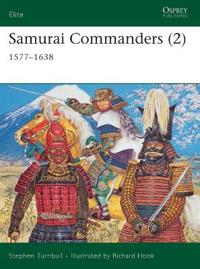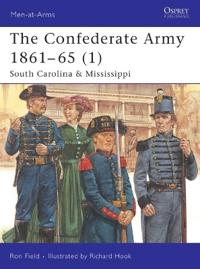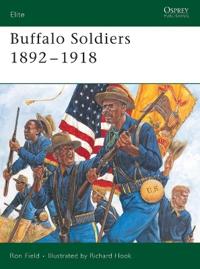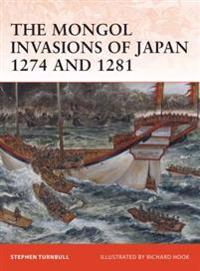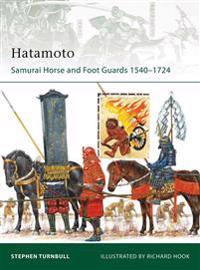Encyclopedia of Native Tribes of North America (Inbunden)
avMichael Johnson, Richard Hook
ISBN: 9781554073078 - UTGIVEN: 200709Review of the previous edition: ""A model of excellence in the art of reference volume publishing... Every public and school library... should acquire this treasure. It will remain the standard for many years to come."" - Dr. James A. Clifton, Department of Anthropology, Western Michigan University [...]
Office of Strategic Services 1942-45 (Pocket)
avEugene Liptak, Richard Hook, Eugene Liptak
ISBN: 9781846034633 - UTGIVEN: 200908The Office of Strategic Services, the forerunner of the CIA, was founded in 1942 by William 'Wild Bill' Donovan under the direction of President Roosevelt. Agents were enlisted from both the armed services and civilians to produce operational groups specialising in different foreign areas including [...]
Samurai Commanders (2) (Pocket)
avStephen Turnbull, Richard (ILT) Hook, Stephen Turnbull
ISBN: 9781841767444 - UTGIVEN: 2005-08This second volume about Japan's samurai commanders covers the generals of the later years of the Age of the Warring States, a period when only the most able leaders survived. This was a time when the prowess of a commander was measured as much by his strategic and organizational abilities as by hi[...]
The Confederate Army 1861-65 (Pocket)
avRon Field, Richard (ILT) Hook, Ron Field
ISBN: 9781841768496 - UTGIVEN: 2005-05The Southern states which formed the Confederacy in 1861 fielded many units of volunteer troops wearing a remarkably wide variety of uniforms, many of which reflected foreign influences. In a spirit of independence, many states also issued their own uniform regulations on the outbreak of the war bet[...]
Buffalo Soldiers 1892-1918 (Pocket)
avRon Field, Richard (ILT) Hook, Ron Field
ISBN: 9781841768984 - UTGIVEN: 2005-10The segregated regiments of African-American troops represented an important minority in the small US Army at the turn of the 20th century. Units saw service in the Spanish-American War, in the Philippines jungle until 1902 and during the Mexican border campaign of 1916. Finally, in France 1917-18, [...]
World War I Gas Warfare Tactics and Equipment (Pocket)
avSimon Jones, Richard (ILT) Hook, Simon Jones
ISBN: 9781846031519 - UTGIVEN: 2007-01Battlefield Gas was first employed in April 1915 at the village of Langemarck near Ypres. At 1700 hours, the Germans released a five mile-wide cloud of 168 tons of chlorine gas from 520 cylinders, causing panic and death in the French and Algerian trenches. Despite initial widespread condemnation an[...]
Special Operations Forces in Iraq (Pocket)
avLeigh Neville, Richard (ILT) Hook, Leigh Neville
ISBN: 9781846033575 - UTGIVEN: 2008-11In this companion volume to "Elite 163: Special Operations Forces in Afghanistan", Leigh Neville now turns his expert analysis to the Special Operations Forces (SOF) of the US and Coalition allies serving in Iraq since 2003. Filled with recently declassified material, first hand accounts, and unique[...]
The Mongol Invasions of Japan 1274 and 1281 (Pocket)
avStephen R. Turnbull, Richard (ILT) Hook, Stephen R. Turnbull
ISBN: 9781846034565 - UTGIVEN: 2010-01From his seat in Xanadu, the great Mongol Emperor of China, Kubla Khan, had long plotted an invasion of Japan. However, it was only with the acquisition of Korea, that the Khan gained the maritime resources necessary for such a major amphibious operation. Written by eastern warfare expert Stephen Tu[...]
The Seminole Wars 1818-58 (Pocket)
avRon Field, Richard (ILT) Hook, Ron Field
ISBN: 9781846034619 - UTGIVEN: 2009-08The Seminole of Florida were one of five so-called 'Civilized Tribes' who for many years lived in peace with the settlers. However, by 1815, frontier Americans had grown increasingly envious of their relative wealth and land, and resentful of their harbouring of former slaves. This book reveals the [...]
Hatamoto (Pocket)
avStephen Turnbull, Richard (ILT) Hook, Stephen Turnbull
ISBN: 9781846034787 - UTGIVEN: 2010-03Each great samurai warlord, or daimyo, had a division of troops known as the Hatamoto, 'those who stand under the flag'. The Hatamoto included the personal bodyguards, the senior generals, the standard bearers and colour-guard, the couriers, and the other samurai under the warlord's personal command[...]
The Praetorian Guard (Pocket)
avBoris Rankov, Richard (ILT) Hook, Boris Rankov
ISBN: 9781855323612 - UTGIVEN: 1994-01The Praetorian Guard of Imperial Rome was the power behind the throne, with the ability to make or break an emperor. As the main body of troops in Rome, they were the emperor's instrument to discourage plotting and rebellion and to crush unrest. The emperor's most immediate line of defence, they cou[...]




